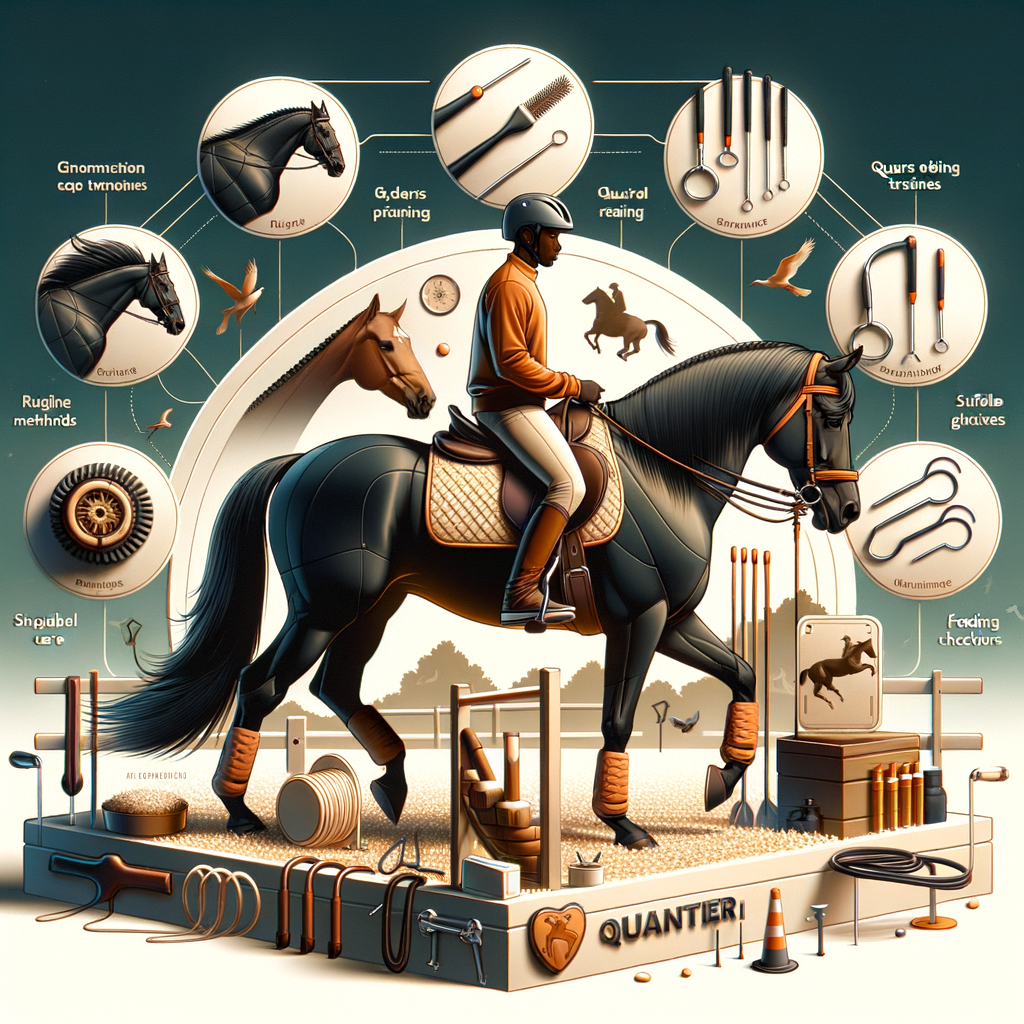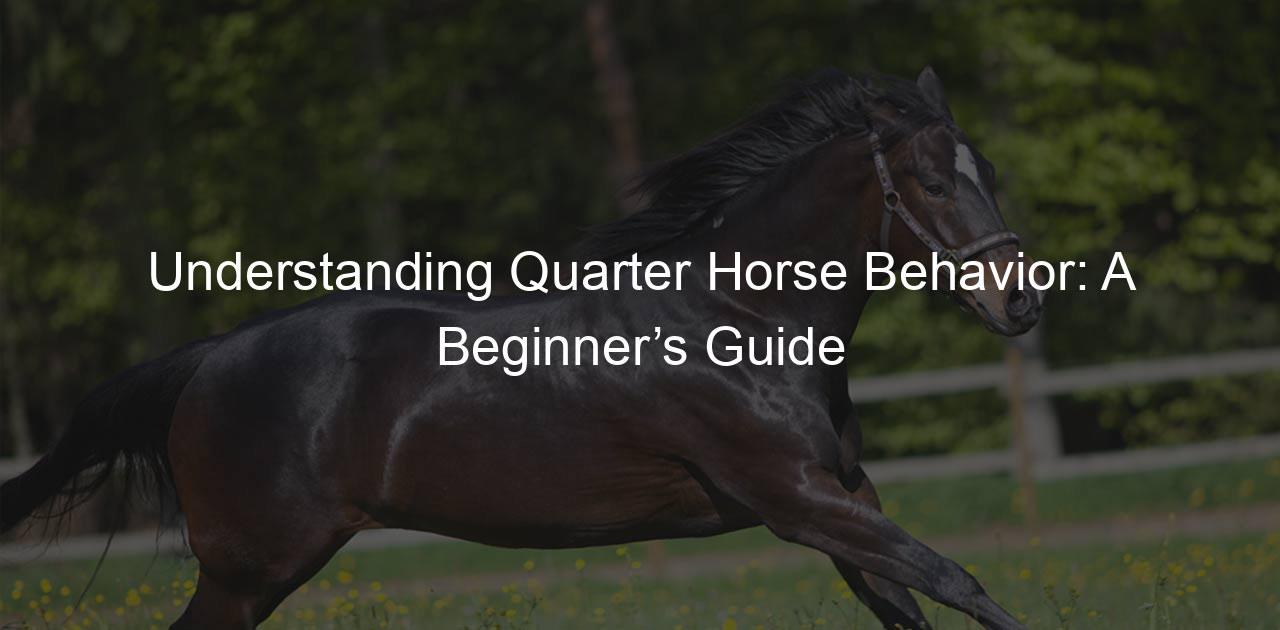
Introduction to Quarter Horse Riding
Have you ever wondered about the world of horse riding, specifically Quarter Horse riding? This post will guide you through the basics and importance of this popular equestrian sport. Let’s saddle up and get started!
-
- Understanding the basics of Quarter Horse Riding
The American Quarter Horse, known for its speed and agility, is a breed that has won the hearts of many equestrians worldwide. Quarter Horse riding involves not only riding these magnificent creatures but also understanding their unique characteristics and needs.
Firstly, a Quarter Horse is incredibly fast, especially over short distances. They are known to outpace other breeds in races that are a quarter of a mile long, hence the name ‘Quarter Horse’. Secondly, they are highly versatile and can be used for various activities, from rodeo events to horse shows and even as working ranch horses.
Learning to ride a Quarter Horse involves understanding these traits and knowing how to handle the horse’s speed and agility. It also requires learning basic riding skills, such as maintaining balance, controlling the horse’s direction, and communicating with the horse through subtle body movements and signals.
-
- Importance of Quarter Horse Riding
Quarter Horse riding is more than just a sport; it’s a way to connect with nature, improve physical fitness, and develop personal discipline and responsibility. Here are some reasons why Quarter Horse riding is important:
-
-
- Physical Fitness: Horse riding is a great way to improve balance, coordination, and overall physical fitness. It engages multiple muscle groups and provides a good cardiovascular workout.
- Mental Health: Riding a horse can also have significant mental health benefits. It can help reduce stress, improve focus, and boost self-confidence.
- Responsibility and Discipline: Owning and caring for a horse teaches responsibility, while learning to ride requires discipline and perseverance.
- Connection with Nature: Horse riding allows you to explore the great outdoors and develop a deeper appreciation for nature.
-
Whether you’re a seasoned rider or a beginner, Quarter Horse riding offers a unique and rewarding experience. So why not give it a try?
Enhancing Your Horse Riding Experience
Whether you’re a beginner or an experienced rider, there’s always room for improvement. Here are some tips to enhance your horse riding experience and skills.
Improving Horse Riding Skills
- Mastering the basic horse riding techniques: Start by learning the basic techniques such as mounting, dismounting, steering, and stopping. Practice these until they become second nature.
- Advanced horse riding techniques to learn: Once you’ve mastered the basics, you can move on to more advanced techniques like cantering, galloping, and jumping.
- Key tips to enhance your Quarter Horse Riding experience: Always maintain a balanced position, keep your heels down, and remember to breathe and relax. The more relaxed you are, the more comfortable your horse will be.
- Common mistakes to avoid in Quarter Horse Riding: Some common mistakes include gripping with your knees, leaning forward, and not keeping your heels down. Avoid these to improve your riding skills.
- Effective training techniques for your Quarter Horse: Make sure to use positive reinforcement and consistency in your training. This will help your horse learn more effectively.
- Case study: Successful training techniques: A study showed that horses trained with positive reinforcement techniques showed better results than those trained with traditional methods.
- Essential equipment for Quarter Horse training: Some essential equipment includes a saddle, bridle, and riding helmet. These will help ensure your safety and comfort while riding.
- How to choose the right equipment for your horse: Consider your horse’s size, breed, and comfort when choosing equipment. The right equipment can make a big difference in your horse’s performance and well-being.
- Factors to consider when choosing horse riding equipment: Consider factors such as quality, fit, and price when choosing your horse riding equipment.
- Recommended horse riding equipment for beginners: Beginners should start with basic equipment like a saddle, bridle, and helmet. As you gain more experience, you can invest in more advanced equipment.
- Tips for maintaining your horse riding equipment: Regularly clean and inspect your equipment to ensure it’s in good condition. This can help prolong its lifespan and ensure your safety.
- Importance of regular equipment checks: Regular equipment checks can help prevent accidents and injuries. Always check your equipment before and after each ride.
- Essential elements of basic horse care: Basic horse care includes feeding, grooming, and regular veterinary checks. Proper care can help ensure your horse’s health and well-being.
- Common horse health issues and how to prevent them: Common health issues include colic, lameness, and respiratory problems. Regular veterinary checks and proper care can help prevent these issues.
- Advanced care techniques for your Quarter Horse: Advanced care techniques include regular exercise, proper nutrition, and mental stimulation. These can help keep your horse healthy and happy.
- Importance of regular veterinary checks: Regular veterinary checks can help detect any health issues early and ensure your horse is in good health.
- Exercises to improve your horse riding skills: Regular practice, along with exercises like yoga and pilates, can help improve your balance and strength, enhancing your horse riding skills.
- How regular practice can enhance your equestrian experience: Regular practice not only improves your skills but also strengthens the bond between you and your horse, enhancing your overall equestrian experience.
- Key safety tips for horse riding: Always wear a helmet, maintain a balanced position, and never ride alone. These safety tips can help prevent accidents and injuries.
- Importance of wearing the right safety gear: Wearing the right safety gear can protect you from serious injuries. Always wear a helmet, boots, and gloves when riding.









